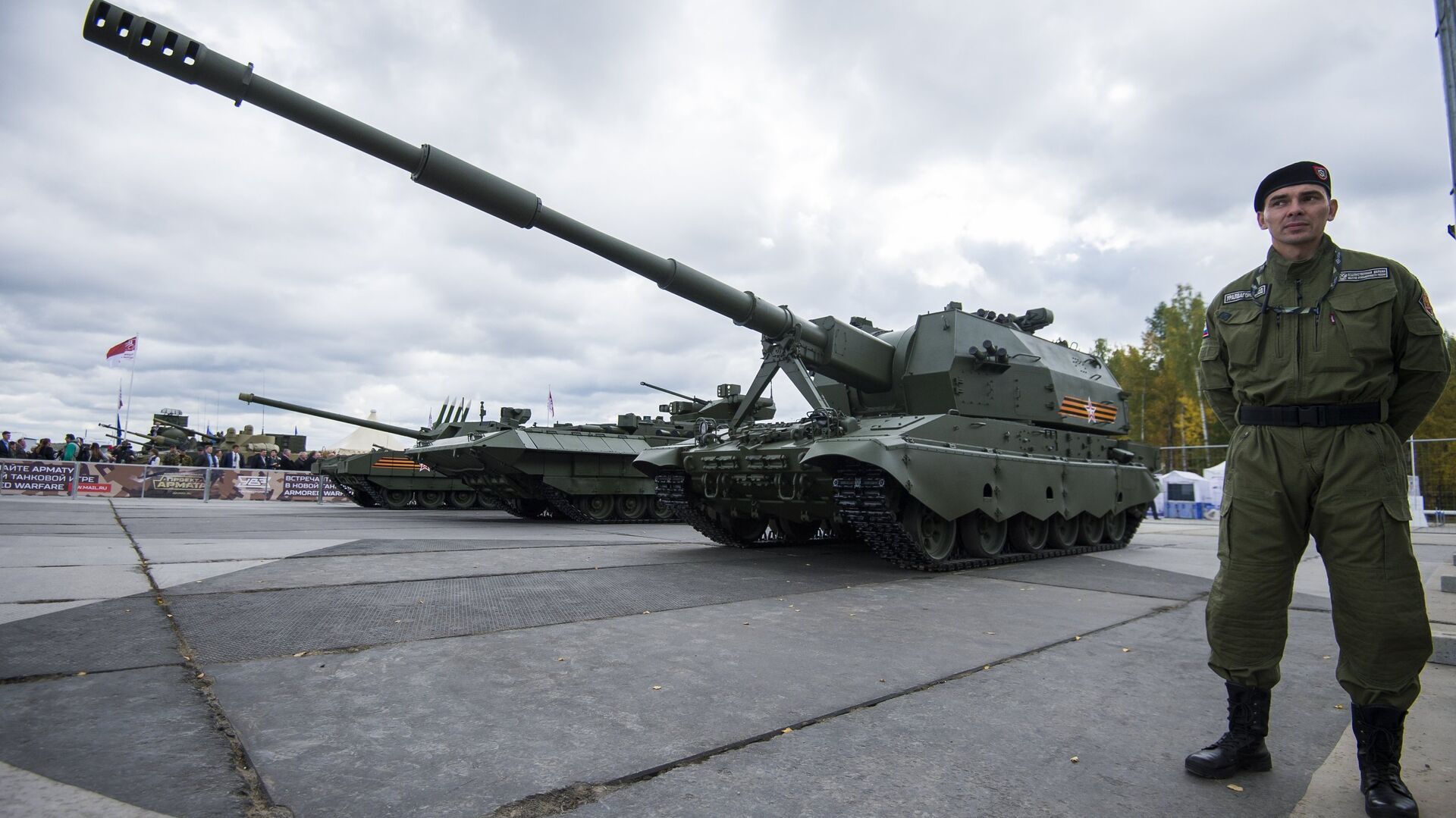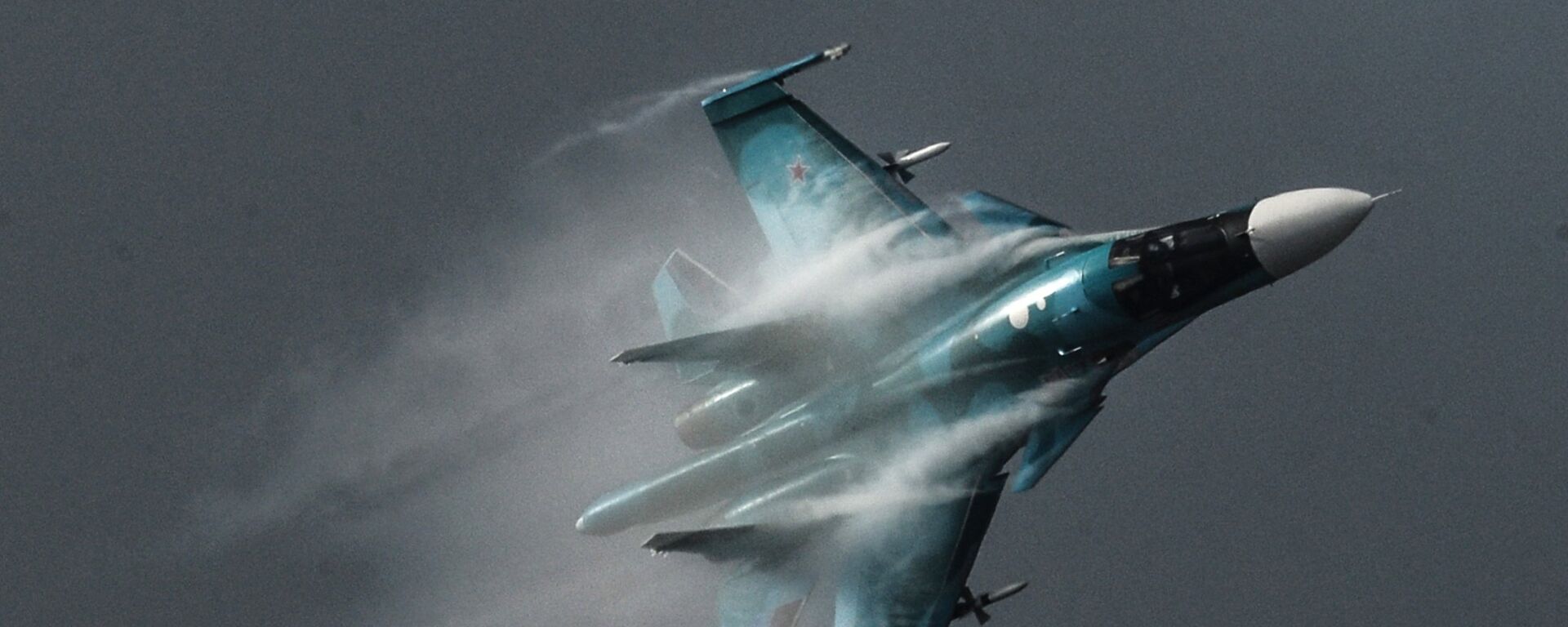https://sputniknews.in/20230930/russian-coalition-artillery-gun-attractive-to-india-expert-4519206.html
Russian 'Coalition' Artillery Gun Attractive to India: Expert
Russian 'Coalition' Artillery Gun Attractive to India: Expert
Sputnik India
Russia would be happy to tie up with India for joint production of long-range artillery guns for the Indian Army, a Russian military expert has said.
2023-09-30T18:20+0530
2023-09-30T18:20+0530
2023-10-02T14:57+0530
sputnik exclusives
india
russia
ukraine
rosoboronexport
special military operation
russian armed forces
ukraine armed forces
moscow
delhi
https://cdn1.img.sputniknews.in/img/07e7/09/1e/4528894_0:123:3206:1926_1920x0_80_0_0_99a24aa8f1c6ab69080d27ad6ae81ab9.jpg
Russia would be happy to set up a joint production facility for long-range artillery guns for the Indian Army, a Russian military expert has said.The comments by Dmitry Kornev, the founder of the Military Russia portal, come in the wake of media reports that India will purchase 400 self-propelled long-range artillery units, as such weapons have proven effective during the conflict in Ukraine.Advantages of Long-Range Artillery Guns He added that modern artillery guns are without any special trucks, tractors, and other things, and can arrive somewhere in an open field, turn around, work on the enemy, and leave. Furthermore, the artillery crew does not go beyond the scope of combat vehicles.In addition, he remarked, a modern self-propelled gun carries both communication and navigation equipment. That is, being inside such a machine, the calculation knows at what coordinate point it is located.That's why the crew can quite effectively direct his weapon, and control it, they have ammunition at hand right here, in the same installation. It's very effective, very secure, very efficient.Moreover, according to Kornev, the special military operation showed that the choice of self-propelled artillery units as the main artillery by many armies of the world is justified.Different Types of Russian Artillery Guns in Operation He revealed that on the Russian side, probably the main installation is the Msta-S, which is a self-propelled 152 mm caliber gun.Kornev underlined that the Msta-S installation provides the cross-country ability of the T-90 tank as its modern versions of the chassis are from this tank. This setup can go anywhere like a tank can go. This is beyond the control of most towed artillery pieces and most other self-propelled guns.Besides, this installation can receive all suitable information about targets via communication channels, meaning via radio, including in protected mode. Moreover, the artillery gun carries all the ammunition, if additionally necessary, it can supply ammunition from the outside, from the ground.Also, Kornev disclosed that Russian arms company Uralvagonzavod is on the verge of completing work on the Coalition artillery system. The self-propelled unit will take all the best from Msta-S - an updated chassis from the T-90 and a new artillery unit. The Coalition system, in terms of its characteristics, should be equal to its Western counterparts.Moscow's Offerings to New Delhi On being asked if India would be interested in acquiring any of the artillery guns Moscow has used so effectively in Ukraine, the military pundit noted that the most interesting export option for New Delhi would be the "Coalition".He expressed that it would be a bonus for India because it was already working with Russian tanks. New Delhi assembled T-72 tanks, and they are armed with the T-90 tank, models of the late 90s and early 2000s.Kornev mentioned that both installations have practically the same chassis, a very similar body, and a lot of interchangeable parts. That is, this would be a very effective solution and Rosoboronexport, most likely, is offering exactly this solution to India.Kornev pointed out that Russia has been working with India on armored vehicles for many years, many decades. Plus, as it is inexpensive and familiar to Indians, they could very quickly master production and assembly, the pundit noted.Russia Deploying Long-Range Artillery For DecadesMeanwhile, Major General (Retd) Sanjay Soi, who had an over three-decade stint in the Indian Army, stressed that Russia has always been using artillery guns as its primary weapons system for many decades. Even in previous wars, including the Second World War, the Russians have used artillery deployment to good effect.Generally, the Russian Armed Forces bring out heavy fire on the enemy frontlines to cause huge destruction to the warfighting capabilities of the enemy, including both in self-defense and attack.Because of its range, the Russians can strike deep inside enemy formations, allowing them to support the infantry and armored units to capture ground.Artillery Guns Won India the Kargil WarLike Russia, India has also been using artillery to a great extent. Even in past wars, artillery has played a major role in tilting the balance of war in India's favor.This is perhaps why India has decided to order 400 self-propelled artillery guns, which is aimed at enhancing the firepower of the Indian Army, considering the present situation on the borders with Pakistan and China.India's Latest Move Influenced by Russian Success in UkraineSoi said that as far as artillery is concerned, India has already inducted a vast array of domestically produced weapons, like the Dhanush howitzers, and K9 Vajras, while older such platforms have been upgraded.The former Indian Army veteran argued that India's latest move to add 400 artillery guns to its arsenal has been influenced by the success of Russia in the Ukraine conflict.
https://sputniknews.in/20230929/russias-su-34-fighter-bomber-gives-ukraine-nightmares-ahead-of-winter-4505821.html
india
russia
ukraine
moscow
delhi
new delhi
kiev
Sputnik India
feedback.hindi@sputniknews.com
+74956456601
MIA „Rossiya Segodnya“
2023
Pawan Atri
https://cdn1.img.sputniknews.in/img/07e6/0c/13/139630_147:0:831:684_100x100_80_0_0_8fa2b25903e7787fe6a2698552c167df.png
Pawan Atri
https://cdn1.img.sputniknews.in/img/07e6/0c/13/139630_147:0:831:684_100x100_80_0_0_8fa2b25903e7787fe6a2698552c167df.png
News
en_IN
Sputnik India
feedback.hindi@sputniknews.com
+74956456601
MIA „Rossiya Segodnya“
Sputnik India
feedback.hindi@sputniknews.com
+74956456601
MIA „Rossiya Segodnya“
Pawan Atri
https://cdn1.img.sputniknews.in/img/07e6/0c/13/139630_147:0:831:684_100x100_80_0_0_8fa2b25903e7787fe6a2698552c167df.png
india self-propelled guns, india artillery guns, india 400 artillery guns, india self-propelled guns, russia offers joint production of artillery guns, india self-propelled guns ukraine, india self-propelled guns ukraine war, india self-propelled guns russian success ukraine, india self-propelled guns russian success ukraine war, india russia defense ties, india russia military relations, india russia military cooperation, india russia artillery guns co-production,
india self-propelled guns, india artillery guns, india 400 artillery guns, india self-propelled guns, russia offers joint production of artillery guns, india self-propelled guns ukraine, india self-propelled guns ukraine war, india self-propelled guns russian success ukraine, india self-propelled guns russian success ukraine war, india russia defense ties, india russia military relations, india russia military cooperation, india russia artillery guns co-production,
Russian 'Coalition' Artillery Gun Attractive to India: Expert
18:20 30.09.2023 (Updated: 14:57 02.10.2023) Russia is India's largest defense partner, with around 50 percent of the weapons used by the armed forces of the South Asian country being of Russian origin.
Russia would be happy to set up a joint production facility for long-range artillery guns for the Indian Army, a Russian military expert has said.
The comments by Dmitry Kornev, the founder of the Military Russia portal, come in the wake of media reports that India will purchase 400 self-propelled long-range artillery units, as such weapons have proven effective during the conflict in Ukraine.
Explaining the advantages of long-range artillery guns, the defense analyst stated that self-propelled artillery installations could be an artillery gun, a cannon, or a howitzer, with a medium and large caliber, which is located on a self-propelled tracked or wheeled base.
Advantages of Long-Range Artillery Guns
He added that modern artillery guns are without any special trucks, tractors, and other things, and can arrive somewhere in an open field, turn around, work on the enemy, and leave. Furthermore, the artillery crew does not go beyond the scope of combat vehicles.
"Based on the results of the current state of the special military operation in Ukraine, it is likely that self-propelled artillery is the most effective type of artillery that is used now," Kornev told Sputnik India on Saturday.
In addition, he remarked, a modern self-propelled gun carries both communication and navigation equipment. That is, being inside such a machine, the calculation knows at what coordinate point it is located.
That's why the crew can quite effectively direct his weapon, and control it, they have ammunition at hand right here, in the same installation. It's very effective, very secure, very efficient.
"These types of self-propelled artillery mounts are much more expensive than conventional guns that are on two wheels and towed by trucks, but it is worth it because their survivability is greatly improved and their effectiveness is also increased," he stressed.
Moreover, according to Kornev, the special military operation showed that the choice of self-propelled artillery units as the main artillery by many armies of the world is justified.
Different Types of Russian Artillery Guns in Operation
He revealed that on the Russian side, probably the main installation is the Msta-S, which is a self-propelled 152 mm caliber gun.
Kornev underlined that the Msta-S installation provides the cross-country ability of the T-90 tank as its modern versions of the
chassis are from this tank. This setup can go anywhere like a tank can go. This is beyond the control of most towed artillery pieces and most other self-propelled guns.
Besides, this installation can receive all suitable information about targets via communication channels, meaning via radio, including in protected mode. Moreover, the artillery gun carries all the ammunition, if additionally necessary, it can supply ammunition from the outside, from the ground.
Also, Kornev disclosed that Russian arms company Uralvagonzavod is on the verge of completing work on the Coalition artillery system. The self-propelled unit will take all the best from Msta-S - an updated chassis from the T-90 and a new artillery unit. The Coalition system, in terms of its characteristics, should be equal to its Western counterparts.
Moscow's Offerings to New Delhi
On being asked if India would be interested in acquiring any of the artillery guns Moscow has used so effectively in Ukraine, the military pundit noted that the most interesting export option for New Delhi would be the "Coalition".
He expressed that it would be a bonus for India because it was already working with Russian tanks. New Delhi assembled T-72 tanks, and they are armed with the T-90 tank, models of the late 90s and early 2000s.
"India could easily produce, and one of their conditions is that they assemble themselves; they could easily assemble self-propelled guns of the Msta-S type, but more advanced, based on the T-90. Or the Coalition type, which
is definitely more advanced than Msta-S," Kornev elaborated.
Kornev mentioned that both installations have practically the same chassis, a very similar body, and a lot of interchangeable parts. That is, this would be a very effective solution and Rosoboronexport, most likely, is offering exactly this solution to India.
Kornev pointed out that Russia has been working with India on armored vehicles for many years, many decades. Plus, as it is inexpensive and familiar to Indians, they could very quickly master production and assembly, the pundit noted.
Russia Deploying Long-Range Artillery For Decades
Meanwhile, Major General (Retd) Sanjay Soi, who had an over three-decade stint in the Indian Army, stressed that Russia has always been using artillery guns as its primary weapons system for many decades. Even in previous wars, including the Second World War, the Russians have used artillery deployment to good effect.
Generally, the Russian Armed Forces bring out heavy fire on the enemy frontlines to cause huge destruction to the warfighting capabilities of the enemy, including both in self-defense and attack.
Because of its range, the Russians can strike deep inside enemy formations, allowing them to support the infantry and armored units to capture ground.
Artillery Guns Won India the Kargil War
Like Russia, India has also been using artillery to a great extent. Even in past wars, artillery has played a major role in tilting the balance of war in India's favor.
"For example, during the
Kargil war against Pakistan, the Bofors guns played an important role in recapturing several strategic heights, including the Tiger Hill.
This is perhaps why India has decided to order 400 self-propelled artillery guns, which is aimed at enhancing the firepower of the Indian Army, considering the present situation on the borders with Pakistan and China.
In this context, the top military brass of the country has been focusing on modernizing the armed forces through acquisitions of several weapons systems, like fighter aircraft, submarines, tanks, and aircraft carriers amongst many other items.
India's Latest Move Influenced by Russian Success in Ukraine
Soi said that as far as artillery is concerned, India has already inducted a vast array of domestically produced weapons, like the Dhanush howitzers, and K9 Vajras, while older such platforms have been upgraded.
The former Indian Army veteran argued that India's latest move to add 400 artillery guns to its arsenal has been influenced by the success of Russia in the Ukraine conflict.
"I would say that Russia has been able to sustain itself for over 20 months in Ukraine because it is domestically building its artillery guns that have caused maximum damage to enemy troops," Soi concluded.



